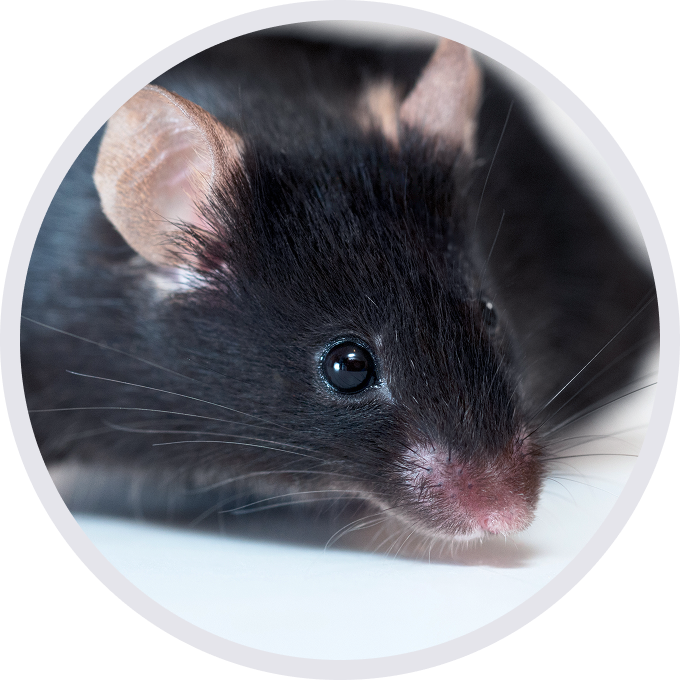
C57BL/6-Tnfrsf9tm1(TNFRSF9)Bcgen/Bcgen • 110004

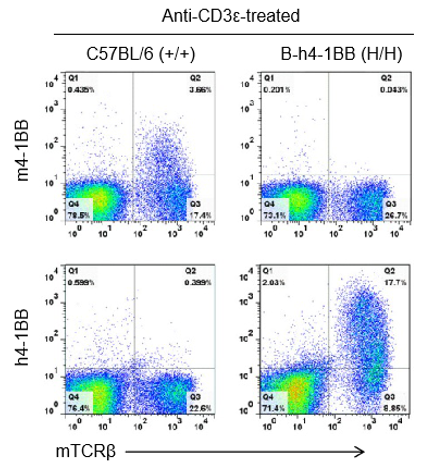



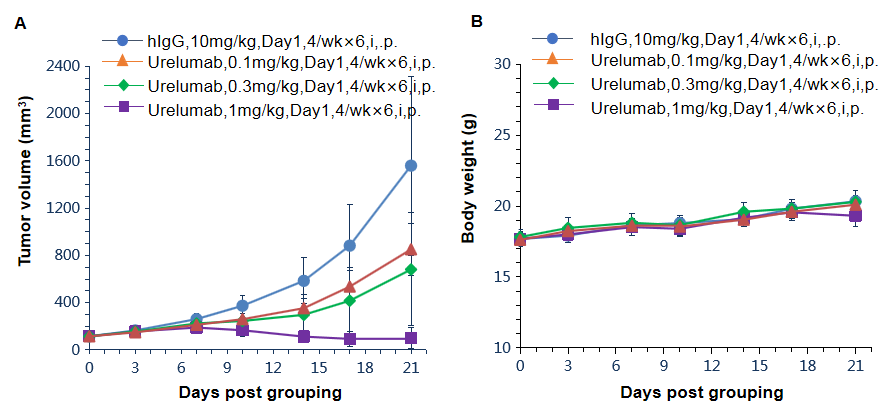

Antitumor activity of anti-human 4-1BB antibodies in B-h4-1BB mice. (A) Anti-human 4-1BB antibodies inhibited MC38 tumor growth in B-h4-1BB mice. Murine colon cancer MC38 cells were subcutaneously implanted into homozygous B-h4-1BB mice (female, 6-7 week-old, n=5). Mice were grouped when tumor volume reached approximately 100 mm3, at which time they were treated with anti-human 4-1BB antibody utomilumab (in house) with doses and schedules indicated in panel. (B) Body weight changes during treatment. As shown in panel A, anti-human 4-1BB antibodies were efficacious in controlling tumor growth in B-h4-1BB mice, demonstrating that the B-h4-1BB mice provide a powerful preclinical model for in vivo evaluation of anti-human 4-1BB antibodies. Values are expressed as mean ± SEM.

Antitumor activity of anti-human 4-1BB antibodies in B-h4-1BB mice. (A) Anti-human 4-1BB antibodies inhibited MC38 tumor growth in B-h4-1BB mice. Murine colon cancer MC38 cells were subcutaneously implanted into homozygous B-h4-1BB mice (female, 6-7 week-old, n=8). Mice were grouped when tumor volume reached approximately 100 mm3, at which time they were treated with two anti-human 4-1BB antibodies with doses and schedules indicated in panel. (B) Body weight changes during treatment. As shown in panel A, anti-human 4-1BB antibodies were efficacious in controlling tumor growth in B-h4-1BB mice, demonstrating that the B-h4-1BB mice provide a powerful preclinical model for in vivo evaluation of anti-human 4-1BB antibodies. Values are expressed as mean ± SEM.

Antitumor activity of anti-human 4-1BB antibodies in B-h4-1BB mice. (A) Anti-human 4-1BB antibodies inhibited MC38 tumor growth in B-h4-1BB mice. Murine colon cancer MC38 cells were subcutaneously implanted into homozygous B-h4-1BB mice (female, 6-7 week-old, n=5). Mice were grouped when tumor volume reached approximately 100 mm3, at which time they were treated with anti-human 4-1BB antibody utomilumab (in house) or urelumab (in house) with doses and schedules indicated in panel. (B) Body weight changes during treatment. As shown in panel A, anti-human 4-1BB antibodies were efficacious in controlling tumor growth in B-h4-1BB mice, demonstrating that the B-h4-1BB mice provide a powerful preclinical model for in vivo evaluation of anti-human 4-1BB antibodies. Values are expressed as mean ± SEM.


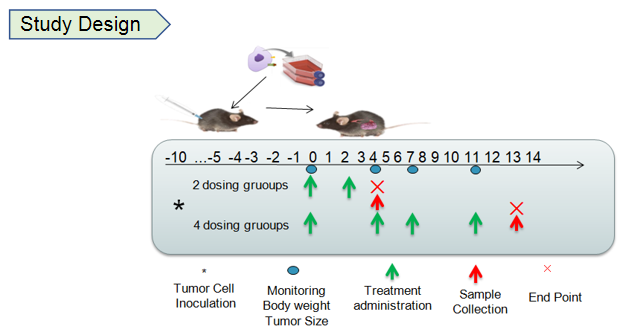

Antitumor activity of anti-human 4-1BB antibodies in B-h4-1BB mice. (A) Anti-human 4-1BB antibodies inhibited MC38 tumor growth in B-h4-1BB mice. Murine colon cancer MC38 cells were subcutaneously implanted into homozygous B-h4-1BB mice (female, 6-7 week-old, n=5). Mice were grouped when tumor volume reached approximately 150 mm3, at which time they were treated with anti-human 4-1BB antibodies with doses and schedules indicated in panel. (B) Body weight changes during treatment. As shown in panel A, anti-human 4-1BB antibodies were efficacious in controlling tumor growth in B-h4-1BB mice, demonstrating that the B-h4-1BB mice provide a powerful preclinical model for in vivo evaluation of anti-human 4-1BB antibodies. Values are expressed as mean ± SEM.

Flow cytometry analysis of tumor infiltrating lymphocytes (TILs). Murine colon cancer MC38 cells were subcutaneously implanted into homozygous B-h4-1BB mice (female, 6-7 week-old, n=5). Mice were grouped when tumor volume reached approximately 150 mm3, at which time they were treated with anti-human 4-1BB antibodies with doses and schedules indicated in panel. Tumor cells were harvested at the endpoint of experiment. Flow cytometry analysis of the tumor infiltrating lymphocytes (TILs) were performed to assess cell number and frequency changes compared to the group with no anti-h4-1BB antibody treated. Leucocytes and total T cells were significantly increased when treated with anti-h4-1BB antibody for four times. Meanwhile, Urelumab may results more CD8+ T cells in the tumor microenvironment, while Treg cells were significantly reduced compared to control groups. Values are expressed as mean ± SEM.
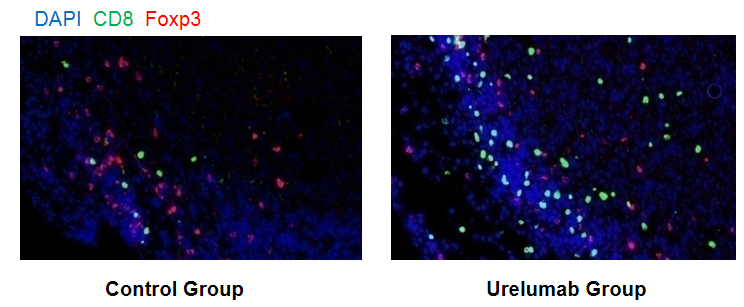
Immunohistochemical (IHC) analysis of paraffin-embedded tumor tissure. Murine colon cancer MC38 cells were subcutaneously implanted into homozygous B-h4-1BB mice (female, 6-7 week-old, n=5). Mice were grouped when tumor volume reached approximately 150 mm3, at which time they were treated with anti-human 4-1BB antibodies with doses and schedules indicated in panel. Tumor tissure were harvested at the endpoint of experiment. Monoclonal antibodies specific for CD8 and Foxp3 are prepared and performed to assess cell number changes compared to the group with no anti-h4-1BB antibody treated by Immunohistochemical. Urelumab group shows more CD8+ T cells in the tumor microenvironment (Green), while Treg cells were significantly reduced compared to control groups (Red). Values are expressed as mean ± SEM.

High-dose urelumab analog (in-house) caused a decline in the liver function of B-h4-1 BB mice. B-h4-1 BB mice were divided into 3 groups and were treated with hIgG4 isotype antibody and urelumab analog respectively. Blood were collected on days 14 and 21 after administration to measure the concentrations of ALT and AST. On day 21, the mice were euthanized and liver tissues were taken for H&E staining. The results showed that in the high-dose group (G3, 20 mg/kg), the ALT levels in the serum of B-h4-1 BB mice significantly increased on days 14 and 21 after administration; The AST level also showed an increasing trend 21 days after drug treatment.

High-dose urelumab analog (in-house) caused chronic inflammatory response in the liver of B-h4-1 BB mice. B-h4-1 BB mice were divided into 3 groups and were treated with hIgG4 isotype antibody and urelumab analog respectively. Blood were collected on days 14 and 21 after administration to measure the concentrations of ALT and AST. On day 21, the mice were euthanized and liver tissues were taken for H&E staining. The results showed that in the high-dose group (G3, 20 mg/kg), 21 days after administration, there was a significant infiltration of inflammatory cells in the liver of B-h4-1 BB mice. It is indicated that the high-dose urelumab analog can cause significant liver toxicity in B-h4-1BB mice.